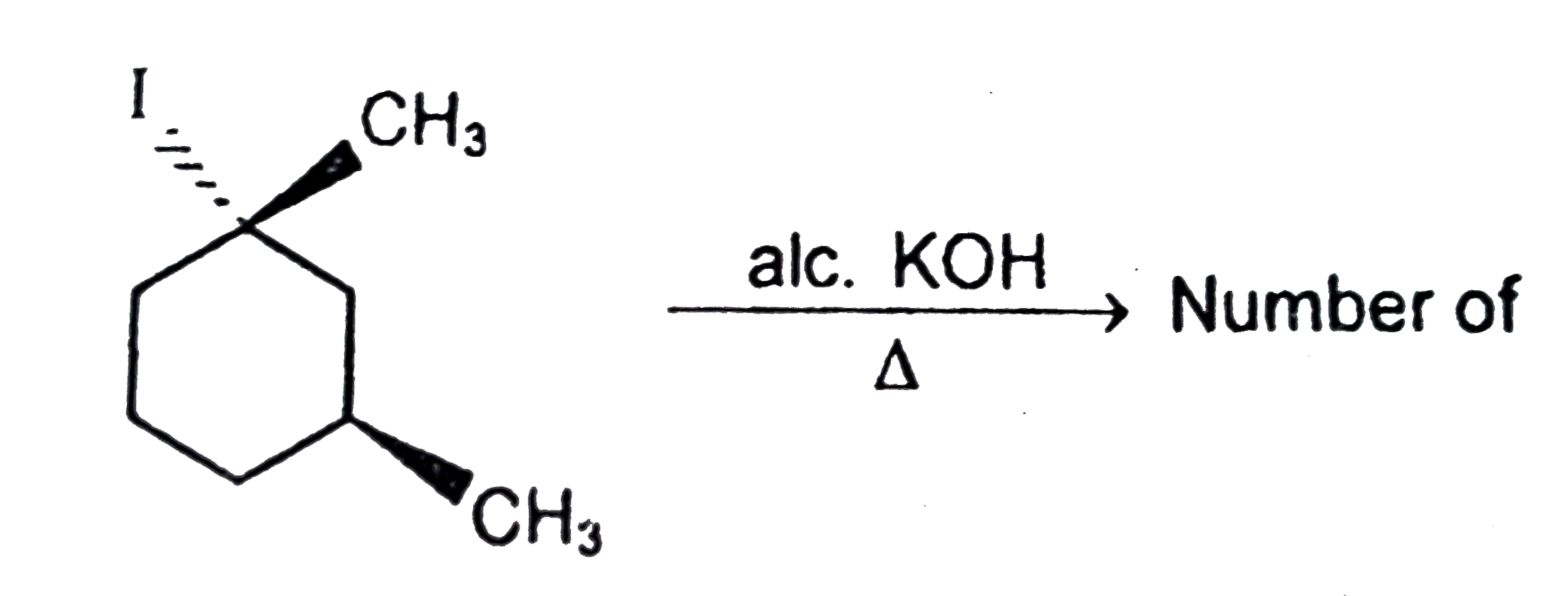When 3-bromo-2,2-dimethyl butane is treated with alcoholic potassiumn hydroxide the number of possible alkene isomers formed is
The correct Answer is:1
To determine the number of possible alkene isomers formed when 3-bromo-2,2-dimethylbutane is treated with alcoholic potassium hydroxide, we can follow these steps:
Step 1: Identify the structure of 3-bromo-2,2-dimethylbutane
3-bromo-2,2-dimethylbutane has the following structure:
Br|CH3−C−CH−CH3|CH3
In this structure, the bromine (Br) is attached to the third carbon of the butane chain, and there are two methyl (CH3) groups attached to the second carbon.
Step 2: Understand the elimination reaction
When 3-bromo-2,2-dimethylbutane is treated with alcoholic potassium hydroxide (KOH), an elimination reaction occurs. This reaction typically leads to the formation of alkenes by removing the bromine atom and a hydrogen atom from adjacent carbons.
Step 3: Identify the possible elimination sites
The bromine is on the third carbon, and we can eliminate a hydrogen from either the second carbon or the fourth carbon. This gives us two potential elimination pathways:
1. Elimination from C2 and C3: This will form an alkene with a double bond between C2 and C3.
2. Elimination from C3 and C4: This will form an alkene with a double bond between C3 and C4.
Step 4: Draw the possible alkenes
1. From C2 and C3:
The resulting alkene will be 2,2-dimethyl-2-butene.
Structure:
CH3∣CH3−C=CH−CH3
2. From C3 and C4:
The resulting alkene will be 3,3-dimethyl-1-butene.
Structure:
CH3−CH2−C=CH2∣CH3
Step 5: Count the isomers
Now, we need to check if there are any geometric (cis/trans) isomers for the alkenes formed:
1. 2,2-dimethyl-2-butene: This compound does not have geometric isomers because the double bond is between two identical groups (the two methyl groups).
2. 3,3-dimethyl-1-butene: This compound also does not have geometric isomers because it has a terminal double bond.
Conclusion
Thus, the total number of possible alkene isomers formed is 2.
3-bromo-2,2-dimethylbutane has the following structure:
When 3-bromo-2,2-dimethylbutane is treated with alcoholic potassium hydroxide (KOH), an elimination reaction occurs. This reaction typically leads to the formation of alkenes by removing the bromine atom and a hydrogen atom from adjacent carbons.
The bromine is on the third carbon, and we can eliminate a hydrogen from either the second carbon or the fourth carbon. This gives us two potential elimination pathways:
2. Elimination from C3 and C4: This will form an alkene with a double bond between C3 and C4.
1. From C2 and C3:
The resulting alkene will be 2,2-dimethyl-2-butene.
Structure:
CH3∣CH3−C=CH−CH3
2. From C3 and C4:
The resulting alkene will be 3,3-dimethyl-1-butene.
Structure:
CH3−CH2−C=CH2∣CH3
Now, we need to check if there are any geometric (cis/trans) isomers for the alkenes formed:
2. 3,3-dimethyl-1-butene: This compound also does not have geometric isomers because it has a terminal double bond.
Thus, the total number of possible alkene isomers formed is 2.
Topper's Solved these Questions
- ALKENESBook:NARAYNAChapter:ALKENESExercise:Straight Objective Questions
Explore 26 Videos
- ALKENESBook:NARAYNAChapter:ALKENESExercise:Matrix Match Type
Explore 3 Videos
- ALKENESBook:NARAYNAChapter:ALKENESExercise:level-5
Explore 2 Videos
- ALKANESBook:NARAYNAChapter:ALKANESExercise:Integer Answer Type
Explore 7 Videos
- ALKYNESBook:NARAYNAChapter:ALKYNESExercise:Level-6
Explore 112 Videos
Similar Questions
Knowledge Check
When an alkyl halide reacts with alcoholic potassium hydroxide to form an alkene the reaction is called as :
Adehydrohalogenation reactionBelimination reactionCincrease in unsaturationDall of the aboveWhen n-butyl chloride is treated with alcoholic potash, the main product formed is _________.
Abut-1-eneBn-butyl alcoholCbut-2-eneDsec-butyl alcoholWhen 3,3-dimethyl butan -2- ol is heated withH2SO4, the major product obtained is
A3,-3-dimethylbut -1- eneB3,3-dimethyl but -2 eneC2,3-dimethylbut-2-eneDcis and trans-isomers of 2,3 dimethylbut -1-ene
"When 3,3 -dimethyl-2-butanol is treated with "HBr" the number of 3o carbons present in the major product formed is.
View SolutionName the product formed when acetic acid is treated with sodium hydroxide solution .
View SolutionWhen 1-bromo-3-chlorocylobutane is treated with two equivalents fo Na, in the presence of ether which of the following will be formed?
View SolutionWhen 1-bromo-3-chlorocylobutane is treated with two equivalents fo Na, in the presence of ether which of the following will be formed?
View Solution2-Brumo butane when treated with Na in the presence of dry ether gives
View Solution

